When you pick up a generic prescription at the pharmacy, you might think the price is simple: a few dollars, maybe even free if you’re on Extra Help. But behind that low cost is a tangled web of federal laws, state regulations, and corporate contracts that decide exactly how much the pharmacy gets paid - and whether they can even afford to fill your prescription. The system wasn’t designed to be fair to pharmacies or transparent to patients. It was built to cut costs for insurers and government programs, often at the expense of the local pharmacy on the corner.
How Generic Drugs Are Paid For: The Two Main Models
There are two primary ways pharmacies get reimbursed for generic drugs: Average Wholesale Price (AWP) and Maximum Allowable Cost (MAC). AWP used to be the standard. It’s based on a list price published by drug manufacturers - a number that often has little to do with what the pharmacy actually paid for the pills. Back in the 2000s, AWP was inflated by as much as 200%, making it a terrible measure of real cost. Today, most payers have moved away from AWP for generics because it’s outdated and misleading. MAC is now the dominant system. It sets a fixed payment cap for each generic drug based on what pharmacies are actually paying in the wholesale market. For example, if the MAC for 30 tablets of generic lisinopril is $4.20, the pharmacy gets paid that amount - no more, no less. If the pharmacy bought the same pills for $5.10, they eat the 90-cent loss. That’s not theoretical. In 2023, the average reimbursement margin for generic drugs was just 1.4%. For some small, independent pharmacies, that’s barely enough to cover rent, staff, and utilities.State Laws and the Battle Over Generic Substitution
Every state has its own laws about whether pharmacists can substitute a brand-name drug with a generic. Most states allow substitution unless the doctor writes "dispense as written" or the patient refuses. But that’s only half the story. What happens after substitution is where the real financial pressure kicks in. Some states, like California and New York, require payers to reimburse at the same rate whether the brand or generic is dispensed. That protects pharmacies from losing money when a patient gets a generic. Other states don’t. In those places, if a pharmacist dispenses a brand-name drug - even if the patient asked for it - they still get paid only the MAC for the generic. That’s a huge risk. Imagine filling a prescription for a brand-name drug that costs $15 to buy, but the system only pays you $4. You’re out $11. No pharmacy can survive that long-term. These laws are why some pharmacists refuse to fill certain brand-name prescriptions. They know they’ll lose money. And they’re not being difficult - they’re trying to stay in business.Medicare Part D and the Hidden Costs of Formularies
Medicare Part D covers nearly 51 million people. It’s supposed to make drugs affordable. But the way it handles generics is anything but simple. Each Part D plan has its own formulary - a list of approved drugs - and divides them into tiers. Generics usually sit on Tier 1, with the lowest copay. But here’s the catch: 28% of Part D plans in 2022 required prior authorization for at least one generic drug. That means even if your doctor prescribes a generic, your plan might block it unless they jump through hoops. Some plans also use step therapy. You have to try a cheaper generic first - even if your doctor says it won’t work for you. If it fails, you can appeal. But the process takes days, sometimes weeks. Patients skip doses. Their conditions worsen. And the pharmacy? They’re stuck waiting for approval while the patient waits in the aisle. The real kicker? Part D plans often don’t tell you the true cost. A drug might be on formulary, but if it’s not preferred, your copay could be double what you expected. And if you’re in the coverage gap - the old "donut hole" - you might pay 25% of the full price, even for a generic. That’s still hundreds of dollars a year for someone on a fixed income.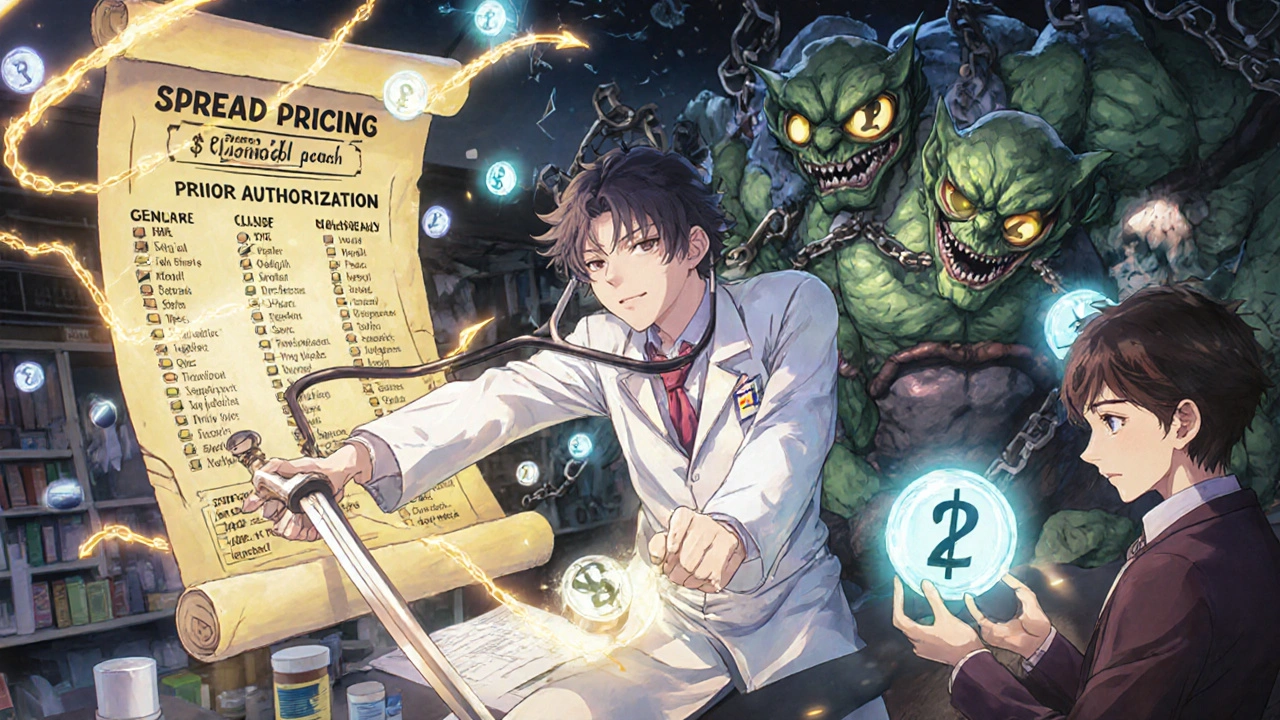
Pharmacy Benefit Managers: The Middlemen Who Control Everything
You’ve never heard of them, but CVS Caremark, Express Scripts, and OptumRX control over 80% of all prescription claims in the U.S. These are pharmacy benefit managers (PBMs). They’re not pharmacies. They’re not insurers. They’re negotiators who work for insurers and Medicare plans to drive down drug costs. How? By negotiating rebates from drug manufacturers. But here’s the problem: PBMs make money in two ways. First, they take a cut of those rebates. Second, they use something called "spread pricing." That’s when they tell the insurer they’re paying $10 for a generic drug, but they only pay the pharmacy $6. The $4 difference? That’s their profit. And it’s hidden from everyone - the patient, the doctor, even the insurer. This system rewards PBMs for keeping reimbursement low. The lower they pay pharmacies, the bigger their spread. And since they control which pharmacies are in-network, independent pharmacies have no leverage. If you don’t accept their terms, you’re out of the system. That’s why 44 states have passed laws to regulate PBM practices - but enforcement is weak.The $2 Drug List: A New Hope for Generic Access
In 2025, CMS is testing a new program called the Medicare $2 Drug List Model. It’s simple: select about 100 to 150 clinically important generic drugs - things like metformin, atorvastatin, levothyroxine - and cap the patient’s copay at $2. No deductible. No formulary restrictions. Just $2, no matter which Part D plan you’re on. This isn’t charity. It’s smart economics. These drugs are cheap to make, widely used, and proven to prevent hospitalizations. If patients can afford them, they take them. If they take them, they get healthier. And if they get healthier, Medicare spends less on ER visits and hospital stays. The model is voluntary, but early feedback from large retailers like Walmart and Kroger shows it works. Their pharmacies already offer these drugs at $2 or less. The question is whether Part D plans will adopt it. And whether PBMs will let them.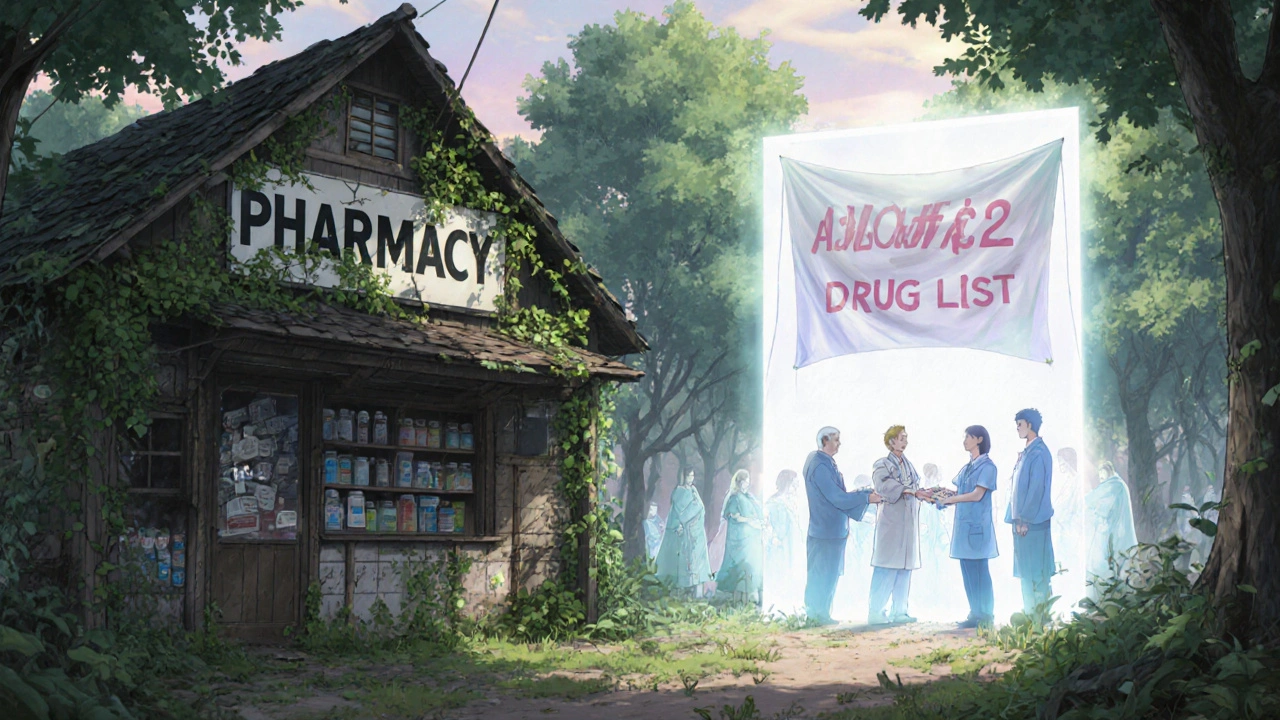
Why Pharmacists Are Struggling - And What It Means for You
Pharmacists aren’t just dispensers. They’re the last line of defense against medication errors, drug interactions, and affordability crises. But the current reimbursement system is pushing them out of business. Independent pharmacies closed at a rate of 1.5% per year from 2018 to 2023. Many of those were in rural areas or low-income neighborhoods. If your local pharmacy closes, you might have to drive 20 miles to get your meds. Or switch to mail-order - which often delays refills and doesn’t offer face-to-face counseling. That’s not convenience. That’s a public health risk. The $2 Drug List could change that. If it succeeds, it could become a national standard. It could force PBMs to stop hiding their spreads. It could give pharmacies a stable, predictable income for the most common generics. But it won’t fix everything. Until laws require transparency in PBM pricing, until states stop letting insurers pay less than the cost of the drug, and until Medicare stops letting formularies block access - the system will keep favoring corporations over patients and pharmacies.What You Can Do
You don’t have to accept this system as normal. Here’s what works:- Always ask your pharmacist: "Can I pay cash instead?" Sometimes, the cash price is lower than your copay - especially for generics.
- Check if your pharmacy offers a $2 or $4 generic list. Walmart, Target, and Costco do. You don’t need insurance.
- If your plan denies a generic, file an appeal. You have the right.
- Ask your doctor to write "dispense as written" only if necessary. Otherwise, let the pharmacist choose the generic.
- Support state laws that cap PBM spreads and require reimbursement transparency.
Why do I sometimes pay more for a generic drug than the cash price?
Your insurance plan may have a high deductible or a copay that’s higher than the actual cash price of the drug. Many pharmacies - like Walmart and Costco - sell common generics for $2 to $4 without insurance. Always ask your pharmacist to compare your copay to the cash price before you pay.
What is MAC pricing, and why does it hurt pharmacies?
MAC stands for Maximum Allowable Cost. It’s the highest amount a pharmacy can be reimbursed for a generic drug. If the pharmacy bought the drug for more than the MAC, they lose money on that prescription. With generic margins as low as 1.4% in 2023, many independent pharmacies can’t survive under MAC-only reimbursement.
How do pharmacy benefit managers (PBMs) affect generic drug prices?
PBMs negotiate rebates with drug makers and set reimbursement rates for pharmacies. They make money by keeping the difference between what insurers pay and what they pay pharmacies - a practice called "spread pricing." This creates a hidden profit and disincentivizes fair reimbursement. PBMs also control which pharmacies are in-network, giving them power to force pharmacies to accept low rates.
Can a pharmacist refuse to fill a brand-name prescription if a generic is available?
In most states, pharmacists can substitute a generic unless the doctor writes "dispense as written" or the patient refuses. But they can’t refuse to fill a brand-name drug just because it’s more expensive - unless they know they’ll lose money and can’t afford to absorb the loss. Many independent pharmacies now avoid filling certain brand-name prescriptions because of low reimbursement rules.
What is the Medicare $2 Drug List, and how will it help?
The Medicare $2 Drug List is a new pilot program that caps the patient’s out-of-pocket cost for about 100-150 essential generic drugs at $2. It removes deductibles and formulary barriers. If successful, it could become permanent, making common generics affordable for millions of seniors and reducing pressure on pharmacies to lose money on every fill.
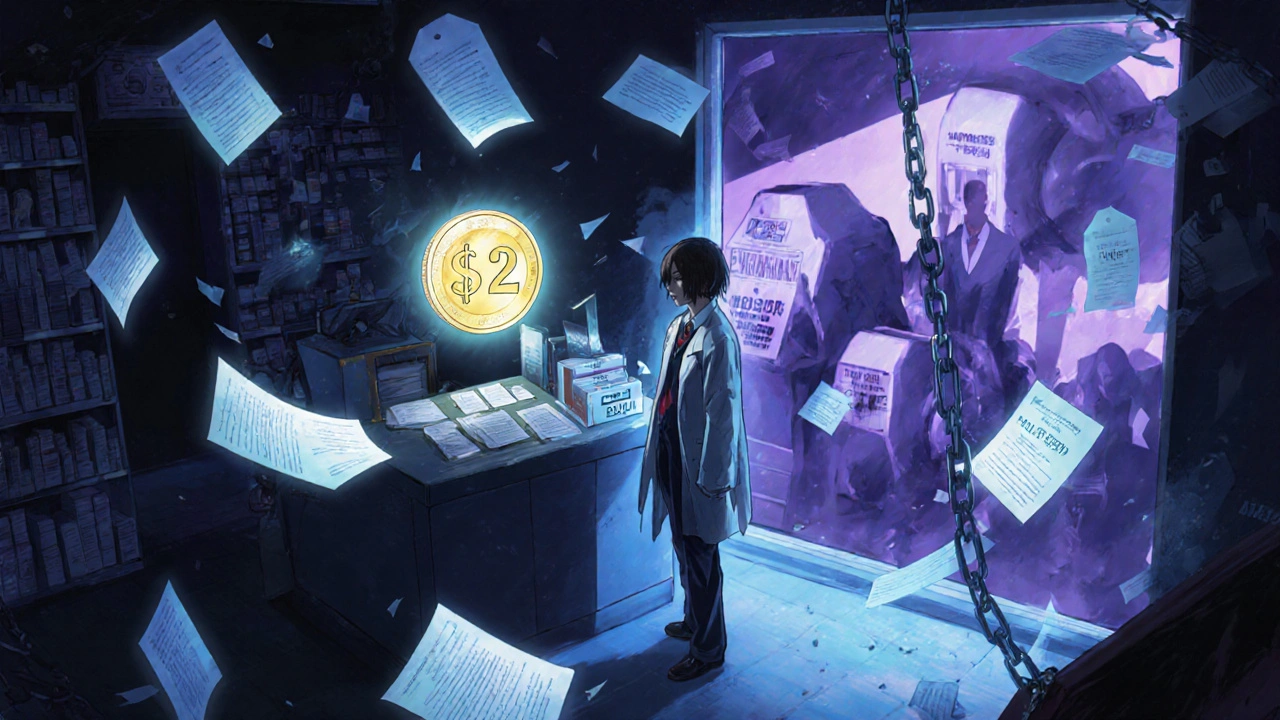

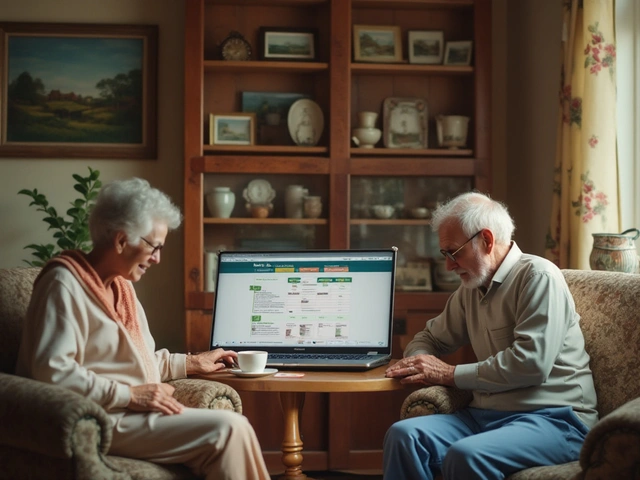

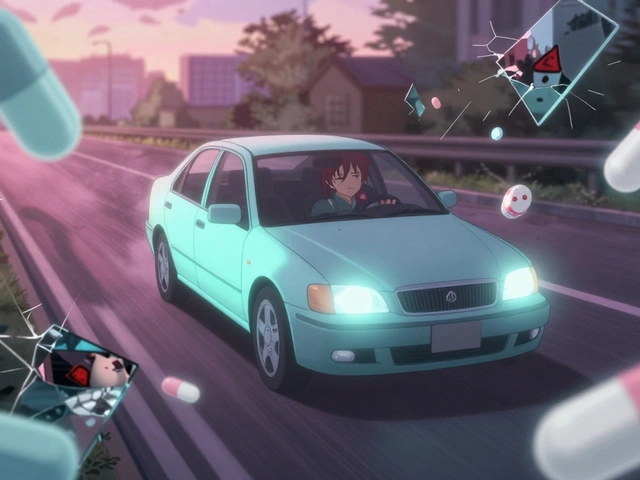

Brianna Groleau
20 November, 2025 . 09:51 AM
It’s insane how we’ve turned something as basic as medicine into a corporate chess game where the players don’t even know the rules. I’ve seen my grandma cry because she couldn’t afford her blood pressure pills even though she’s been paying into Medicare for 40 years. The $2 Drug List? That’s not a pilot-that’s a moral baseline. If we can’t make metformin affordable for seniors, what are we even doing as a society? I don’t care if it’s ‘not market efficient’-human lives aren’t line items on a spreadsheet.
Nick Naylor
22 November, 2025 . 02:44 AM
The MAC system is a regulatory farce-designed by bureaucrats who’ve never stepped foot in a community pharmacy. AWP was corrupt, sure-but MAC is just a legalized extortion racket where PBMs dictate terms to independent pharmacies under the guise of ‘cost containment.’ The data is clear: when reimbursement margins dip below 2%, closures follow within 18 months. This isn’t ‘market discipline’-it’s systemic erasure of local healthcare infrastructure. And the feds? They’re too busy lobbying for PBMs to care.
Sarah Swiatek
23 November, 2025 . 16:34 PM
Let’s be real: PBMs aren’t middlemen-they’re middlemen who’ve weaponized opacity. They take a rebate from the manufacturer, then charge the insurer more than they pay the pharmacy, and call it ‘negotiation.’ Meanwhile, the pharmacist-trained to catch dangerous interactions, to counsel patients on side effects, to spot when someone’s running out of insulin-is treated like a vending machine operator. And we wonder why rural pharmacies are vanishing? It’s not because people don’t need meds-it’s because the system has made it impossible to deliver them without losing money. The $2 Drug List? It’s the first honest policy we’ve seen in a decade. Now let’s force PBMs to disclose their spreads. Or better yet-ban spread pricing entirely.
Dave Wooldridge
23 November, 2025 . 21:30 PM
They’re hiding the real cost because they’re all in on the scam. PBMs, Big Pharma, CMS-it’s all one big pyramid scheme. The $2 Drug List? It’s a distraction. They’re setting up a two-tier system: one for the masses, one for the elite. Soon, the ‘$2’ generics will be the only ones available, and the rest? You’ll need a private insurer, a lawyer, and a blood oath to get them. This is how they control the population. You think you’re saving money? You’re being conditioned to accept less. Wake up. The pills are fine. The system is poisoned.
Rebecca Cosenza
24 November, 2025 . 07:28 AM
Always ask for the cash price. Seriously. It’s not hard. And if your pharmacy won’t tell you? Find one that will. You’re not being ‘difficult’-you’re being responsible.
swatantra kumar
25 November, 2025 . 13:43 PM
Bro, this is wild. In India, we get generics for $0.10–$0.50 and no one bats an eye. Here, people are crying over $4? 😅 The system is broken but also… kind of hilarious? Like, imagine if your phone charger cost $15 because of ‘spread pricing.’ We need a revolution. Or at least a Walmart trip.
Cinkoon Marketing
27 November, 2025 . 08:52 AM
Actually, I think the bigger issue is that most people don’t even know what a PBM is. Like, if you asked 10 people on the street, 9 wouldn’t know. And yet they control everything. It’s like the Fed, but for pills. And no one’s talking about it. Maybe we need a Netflix docuseries. Or a TikTok campaign. #PBMsAreTheRealVillains
robert cardy solano
28 November, 2025 . 16:17 PM
I work at a small pharmacy in Ohio. We lost $12,000 last year just on MAC losses. We’re still here because we sell coffee and vitamins. But I’ve got a 22-year-old tech guy who fills scripts for us-he’s thinking about quitting because he’s tired of watching people choose between food and meds. The $2 list? Yeah. Do it. And don’t make it optional.
Pawan Jamwal
29 November, 2025 . 12:49 PM
USA is a joke. In India, generic drugs are cheaper than bottled water. We have 100+ manufacturers of metformin. Here, you need 3 layers of corporate approval just to get a blood pressure pill. This isn’t capitalism-it’s feudalism with a pharmacy counter. And the fact that you’re even surprised? That’s the real tragedy.
Bill Camp
29 November, 2025 . 13:53 PM
They want to fix this with a $2 list? That’s cute. But until we break up the PBMs, it’s just rearranging deck chairs on the Titanic. These companies have more lobbyists than Congress has members. And they own the data. They know who’s taking what. They know when you skip doses. They’re not just profiting-they’re monitoring. This isn’t healthcare. It’s surveillance with a pill bottle.
Lemmy Coco
30 November, 2025 . 06:46 AM
i just found out my local walmart has a $4 generic list and i’ve been paying $25 copay for my thyroid med for years… i feel dumb. but also kinda angry? like why didn’t anyone tell me? also, is this legal? i think i need to file a complaint or something. sorry for the typos, typing on my phone while crying
rob lafata
1 December, 2025 . 23:31 PM
You people are naive. The $2 Drug List isn’t a solution-it’s a Trojan horse. They’re going to use it to force pharmacies into exclusive contracts with PBMs, then jack up the prices on everything else. This is how monopolies are born. You think you’re getting a deal? You’re being groomed for total dependency. And the worst part? You’ll thank them for it. You’ll post about it on Instagram. You’ll call it ‘progress.’ Meanwhile, the pharmacy down the street closes. And the next thing you know, your kid’s asthma inhaler costs $1,200 because there’s no competition left. This isn’t reform. It’s slow-motion corporate colonization.
Matthew McCraney
3 December, 2025 . 05:37 AM
They’re all in on it. PBMs, Medicare, even the pharmacists-they’re all complicit. You think they don’t know what’s happening? Of course they do. But they’re getting paid to look away. I heard a rumor that some of these MAC rates are set by ex-PBM employees working for state Medicaid offices. That’s not corruption-that’s a goddamn cartel. And the fact that you’re still surprised? That’s the real crime. You’ve been drugged. Literally and figuratively.